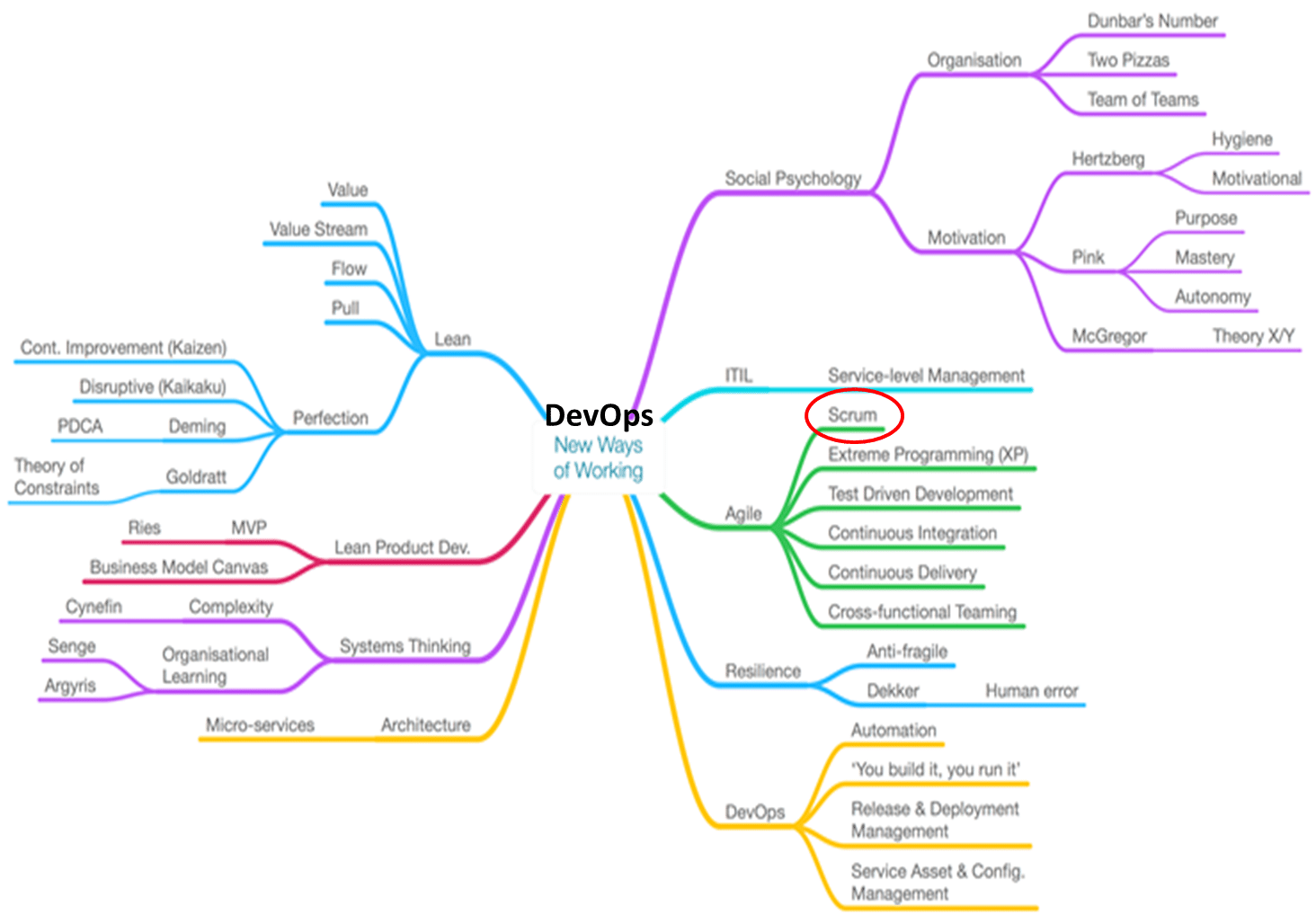Ways to improve delivery: DevOps and Scrum
The term DevOps was coined in 2009 by Patrick DeBois. This term was used to describe a philosophy that focussed on shifting reactionary and process-oriented development operations, to a more disruptive, agile, and functionally dynamic approach. The development of this movement and philosophy was catalysed by the need to improve IT service delivery agility. The strategy behind DevOps involves the removal of unnecessary obstructions to application and service delivery, done through the application of various framework concepts such as Lean, Agile, and Scrum. DevOps not only aims to improve service delivery within the IT industry, but also to promote the collaboration between people, processes/frameworks, and tools to cause a culture shift intended to improve quality of solutions that are business-oriented and can be easily shaped to meet the needs of today.
The foundationanl focus within DevOps is centered on people and culture, seeking to improve overall collaboration between operations and development teams. This is done by implementing the core disciplines associated with the Agile framework, namely: discipline, collaboration, and early feedback to tasks, aiming to ensure that end-to-end project velocity is increases and, thus, improves operational quality. Another important facet in effective utilisation of the DevOps framework is improved utilisation of technology by creating infrastructure as code. This process involves 2 critical steps:
- Ensuring that everything becomes programmable.
- Creating dynamic infrastructure services into collaborative tools chains to improve automated service delivery and management.
Implementing both steps ensures that DevOps adds a new level of automation and repeatability, reducing the necessity for manual efforts, thus, improving agility, availability, and service delivery. The diagram below shows the aforementioned interjecting parts that allow DevOps philosophies to improve agility and delivery.

It is important to note that DevOps itself is not a technology. It is a philosophy or movement intended to improve collaboration between frameworks and improve service delivery within the IT industry. To do this, it takes into consideration the following:
- Cross-functional teams and skills
- Continuous delivery
- Continuous assessment
- Optimum utilisation of toolsets
- Automated deployment pipeline
DevOps, at its core, is an interconnection between multiple frameworks (including Lean, Agile, and Scrum) ensuring collaboration in order to achieve maximum efficiency and effectiveness. It is an accumulations of multiple frameworks, each contributing in various ways to improve collaboration efforts between people, technologies, and processes within the IT industry. This will, in turn, benefit service delivery. These collaborating frameworks forming the DevOps movement are illustrated in the figure below.

For the purpose of this lecture, the Scrum framework and its implications regarding IT service delivery and DevOps will be discussed.
Scrum framework
Scrum can be defined as a “framework within which people can address complex adaptive problems, while productively and creatively delivering products of the highest possible value” (Sutherland & Schwaber, 2016). Scrum is a lightweight, but difficult to master, framework that focusses primarily on creating an environment in which various processes and techniques can be employed effectively. It ensures a clear indication of product management and development practice efficacy, allowing areas of improvement to be observed and, thus, increasing improvement opportunities. This characteristic of Scrum increases awareness regarding areas that may need improvement, therefore, allowing constant improvement to occur and positively impacting functioning and service delivery within the organisation.
The key components of Scrum include:
- Scrum teams

- Events
- Events within a Scrum are time-boxed and prescribed. They are used to minimise unnecessary meetings and create regularity. The time-constraints ensure that no time is wasted, thus, optimising efficiency.
- The events allocate time to inspect the functioning of the team, ensuring transparency and optimising productivity and efficiency.
- Artifacts
- Artifacts within the Scrum represent the work or value of what is being done. Artifacts are designed in a way to increase transparency in order to ensure all-round understanding of the artifact. Artifacts also allow for inspection and adaptation.
The relationships and interactions between each of the aforementioned components are integral to the functioning and effective implementation of the Scrum framework within an organisation. These interactions are illustrated in the figure below.

Conclusion
Optimising service delivery within the IT industry is essential to increasing productivity and overall functionality of the organisation. Implementation of philosophies such as DevOps ensures a cultural shift to a more dynamic approach in which the collaboration between people, processes, and tools. The DevOps movement aims to improve the interaction of multiple frameworks such as Lean, Agile, and Scrum to promote this shift and, in turn, create dynamic infrastructure services and optimise automation and efficiency. The Scrum framework is an example of how optimisation of product value and delivery can be achieved by outlining Team functioning, prescribing events in which wastage is reduced, and creating artefacts that increase transparency and understanding. All of these factors contribute to a shift focussing on a more disruptive, agile, and functionally dynamic approach. This approach will be optimised to improve service delivery within the IT industry, through collaboration between all sectors.
Resources
Cardoza, C., 2017. Spreading Scrum through the enterprise.
Sutherland, J., & Schwaber, K. (2016). The Scrum Guide. The Definitive Guide to Scrum: The Rules of the Game. Scrum.Org and ScrumInc.
Wurster, L. F., Colville, C. H., Somendra , T., & Aditi , R. (2013). Emerging Technology Analysis: DevOps a Culture Shift, Not a Technology. Gartner.
What is next
Previous Post |
Next post |
Role of the CIO |
IT Budgeting |
For all our Modern IT Management Lectures.
For all our Podcasts.